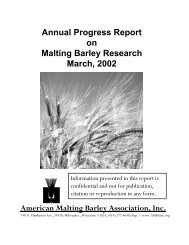Annual Progress Report on Malting Barley Research March, 2007
Annual Progress Report on Malting Barley Research March, 2007
Annual Progress Report on Malting Barley Research March, 2007
You also want an ePaper? Increase the reach of your titles
YUMPU automatically turns print PDFs into web optimized ePapers that Google loves.
5. Collect isolates of barley pathogens and determine their virulence phenotype.<br />
In 2006 we had difficulty in making isolati<strong>on</strong>s from leaf lesi<strong>on</strong>s probably due to the fact that<br />
there were few well developed infecti<strong>on</strong>s <strong>on</strong> the material collected.<br />
A survey of fields was undertaken in July 2006 for comm<strong>on</strong> root rot (CRR) caused by<br />
Bipolaris sorokiniana which finds dry soil c<strong>on</strong>diti<strong>on</strong>s favorable for development.<br />
Cochliobolus sativus was isolated from approximately 80% of the more than 200 sub-crown<br />
internodes showing symptoms. After identificati<strong>on</strong> we subcultured the isolates using a<br />
single c<strong>on</strong>idium in order to ensure that we did not have a mixed culture. The single<br />
c<strong>on</strong>idium isolates were dried down and are in stage at -80 C. We were able to add these<br />
collecti<strong>on</strong>s to the large collecti<strong>on</strong> we amassed in 2002-2006 and they will be used by the<br />
grad student Sanjay Gyawali to study diversity of the pathogen.<br />
6. Molecular Markers and Resistance Genes to Septoria in <strong>Barley</strong>. Dr Se<strong>on</strong>ghee Lee a<br />
PhD student (August 2002-July 2006) completed his research <strong>on</strong> identifying molecular<br />
markers for resistance genes to Septoria leaf blotch in barley. Septoria speckled leaf<br />
blotch (SSLB) caused by the pathogen Septoria passerinii is a comm<strong>on</strong> leaf disease in<br />
cultivated barley in North Dakota. The disease causes ec<strong>on</strong>omic losses in yield and malting<br />
quality, and genetic resistance is the preferred method of c<strong>on</strong>trol. Identificati<strong>on</strong> of molecular<br />
markers for SSLB resistance genes will allow marker-assisted selecti<strong>on</strong> (MAS) in breeding.<br />
To develop molecular markers for resistance, susceptible cultivars were crossed with three<br />
resistant lines, each c<strong>on</strong>taining <strong>on</strong>e the three genes. The F2 generati<strong>on</strong> and F2.3 families<br />
were evaluated for resistance in the green house and F2.3 families in the field. Sequence<br />
tagged site (STS) markers SUBC285, SOPC2, SOPAH5, and SOPBA12 each closely<br />
linked to <strong>on</strong>e of the three genes, were produced from RAPD markers. Another STS marker,<br />
MWG938 linked to Rsp2, was also identified. The STS markers were screened <strong>on</strong> breeding<br />
material with know phenotype as well as diverse genetic material. The STS markers linked<br />
to Rsp genes will be very be useful for maker-assisted selecti<strong>on</strong> and for gene pyramiding<br />
with other genes in barley breeding programs trying to incorporate SSLB resistance in their<br />
cultivars.<br />
In order to utilize the three single dominant genes it is important to know the diversity in the<br />
pathogen and its capacity to develop virulence to the resistance genes. The genetic<br />
structure of Septoria passerinii from nine field populati<strong>on</strong>s was examined at several scales;<br />
within lesi<strong>on</strong>s, am<strong>on</strong>g lesi<strong>on</strong>s in a leaf, am<strong>on</strong>g leaves in a field, and am<strong>on</strong>g fields in ND and<br />
western MN, using amplified fragment length polymorphism (AFLP) markers. A total of 390<br />
isolates were sampled from seven barley fields located in ND and MN. AFLP DNA<br />
fingerprints identified 176 different genotypes am<strong>on</strong>g 390 (n<strong>on</strong>-cl<strong>on</strong>e corrected) isolates in<br />
the nine different fields. In two intensively sampled sites, ND16 (Willist<strong>on</strong> ND) and ND17<br />
(Langd<strong>on</strong> ND), <strong>on</strong>e to four different genotypes <strong>on</strong>ly were found within a lesi<strong>on</strong>. A higher<br />
level of genetic and genotypic diversity was found within a leaf where six to nine different<br />
genotypes were found <strong>on</strong> each leaf. The genetic diversity within a leaf was similar to the<br />
genetic diversity within a field. The pattern of genetic variati<strong>on</strong> within and am<strong>on</strong>g lesi<strong>on</strong>s <strong>on</strong><br />
a leaf was similar to that observed in the closely related Mycosphaerella graminicola which<br />
is known to have regular cycles of sexual reproducti<strong>on</strong> in the field. A lack of correlati<strong>on</strong><br />
between geographical distance and genetic distance was found, and this suggests the<br />
potential for a high level of gene flow between different geographical regi<strong>on</strong>s. The<br />
populati<strong>on</strong> genetic structure described in this study for S. passerinii in North Dakota and<br />
67
















